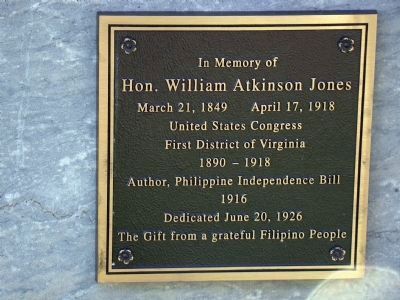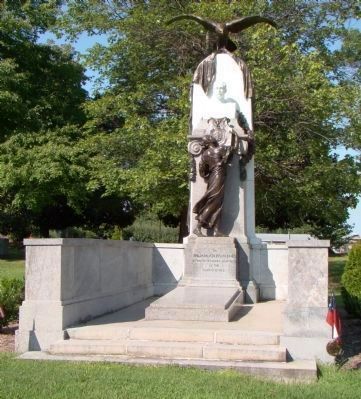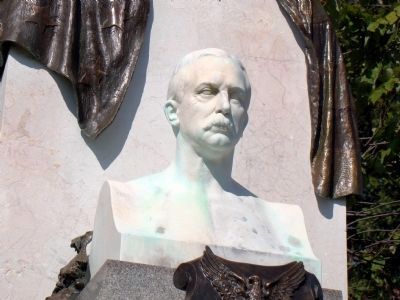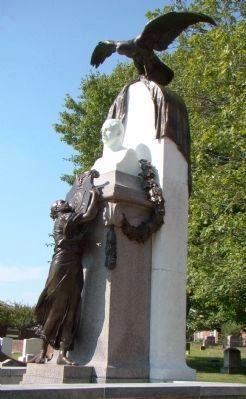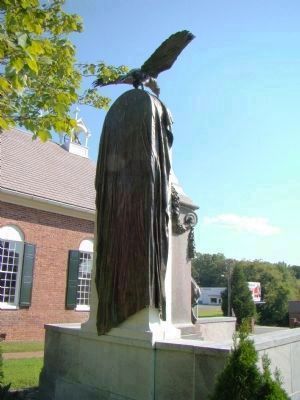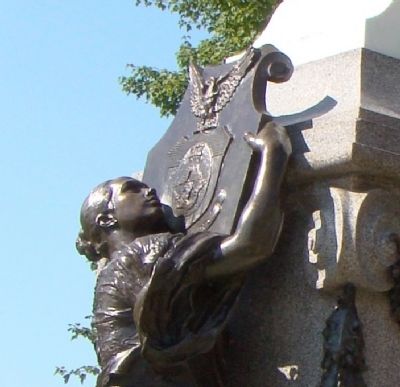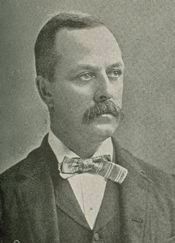Warsaw in Richmond County, Virginia — The American South (Mid-Atlantic)
Hon. William Atkinson Jones
Inscription.
In memory of the Honorable William Atkinson Jones, March 21, 1849 – April 17, 1918. United States Congress, First District of Virginia, 1890–1918.
Author, Philippine Independence Bill, 1916.
Dedicated June 20, 1926; the gift from a grateful Filipino People.
Erected 1926 by the people of the Phillipines.
Topics. This historical marker is listed in this topic list: Government & Politics. A significant historical date for this entry is March 21, 1500.
Location. 37° 57.473′ N, 76° 45.313′ W. Marker is in Warsaw, Virginia, in Richmond County. Marker is on Richmond Road (U.S. 360) east of Main Street, on the left when traveling east. Touch for map. Marker is in this post office area: Warsaw VA 22572, United States of America. Touch for directions.
Other nearby markers. At least 8 other markers are within 5 miles of this marker, measured as the crow flies. Saint John’s Church (about 400 feet away, measured in a direct line); Veterans Memorial (about 600 feet away); Richmond County Courthouse (about 700 feet away); Warsaw (about 700 feet away); Rappahannock Indians (approx. 3 miles away); Francis Lightfoot Lee's Menokin (approx. 4.1 miles away); The Remembrance Structure (approx. 4.2 miles away); Menokin (approx. 4.2 miles away). Touch for a list and map of all markers in Warsaw.
More about this marker. “In the churchyard of St. John’s Episcopal Church stands a white marble portrait bust of William Atkinson Jones atop a tall granite pedestal that marks his grave. Standing in front of the granite pedestal is a bronze allegorical female figure of a Filipino woman. She is dressed in native costume and holds up a large bronze coat-of-arms, which hangs slightly below the marble portrait of Jones. The female figure is installed on a granite base. A tall white marble stele with a rounded top stands as a backdrop to the memorial. Mounted atop the stele is a large bronze bird with wings extended. The bird stands on top of a bronze American flag that draped over the top of the stele. All of the sculptural elements of the memorial stand on a large marble platform that is flanked on three sides by a low marble wall.” —from the The Smithonian American Art Museum’s Art Inventories Catalog
“The memorial cost $35,000, which was funded by the government of the Philippines, with donations of pennies from Philippine school children. The memorial was sculpted by a celebrated Spanish sculptor, Don Mariano Benlliure of Madrid. It was constructed in Spain, then dismantled and shipped to Virginia where it was reassembled. The memorial was erected for the Philippine Government by the U.S. War Dept., Bureau of Insular Affairs, under the supervision of Maj. Joe Sullivan.” —from the The Smithonian American Art Museum’s Art Inventories Catalog
This monument is officially titled the “William Atkinson Jones Mausoleum” but it is also known as the “Filipino Memorial Tribute to William Atkinson Jones,” the “William Atkinson Jones Memorial Monument,” and the “Philippine Memorial to William Atkinson Jones.”
Regarding Hon. William Atkinson Jones. “Warsaw native William Atkinson Jones was a U.S. Congressman from Virginia who served fourteen continuous
terms in the U.S. House of Representatives. He was first elected to Congress in 1890 as a reprentative of the First District of Virginia, a seat he held until his death in 1918. Following the Spanish American War Congressman Jones, as a member of the House Insular Affairs Committee, oversaw the administration of the Philippine Islands, and became a champion for Philippine independence. He is most remembered for passage of the Bill for Philippine independence, which was signed in 1916 by President Woodrow Wilson, and allowed for the gradual transition of powers to the Philippine people. Congressman Jones was much admired and respected by the Philippine people, and his death in 1918 plunged the island into deep mourning. Philippine officials attended the burial in St. John’s churchyard, and the people of the Philippines pledged to erect an American memorial in his honor. He is remembered throughout the Philippines with bridges, streets, and other civic facilities named after him.” —from the The Smithonian American Art Museum’s Art Inventories Catalog
Additional commentary.
1. Memorial Address in the 65th U.S. Congress on February 16, 1919
by Andrew J. Montague, Congressman from Virginia.
Mr. Speaker: Amidst the accumulated work and labor of the closing days of this Congress, the last of the fourteen Congresses in which my late colleague continuously served, we may well pause to recall the life, character, and public services of a Representative so able, faithful, and successful.
William Atkinson Jones was born at Warsaw, the county seat of Richmond
County, Va., on March 21, 1849, and there he lived until his death in the George Washington University Hospital, in the city of Washington, on April 17, 1918. He came from honorable American stock. His great-grandfather, Joseph Jones, was a general in the Revolutionary War, an intimate and trusted friend of Lafayette, and subsequently postmaster of Petersburg, Va., by appointment of Jefferson. Thomas Jones, the son of Joseph, married Mary Lee, the daughter of Richard Lee, long a member of the Virginia House of Burgesses from Westmoreland County, a first cousin of the famous Richard Henry Lee; and from this marriage was born Thomas Jones, the second, who married Anne Seymour Trowbridge, of Plattsburg, N. Y., who were the father and mother of him to whose memory we would at this hour pay homage. I should add that James Trowbridge, his maternal grandfather, was recognized by the Congress for his gallantry at the battle of Plattsburg in 1814. So he came of goodly heritage, a heritage of which he never boasted, but which he exemplified by a life of high purpose and eminent usefulness.
His boyhood fell upon the stormy days of the great War Between the States and upon its abhorrent aftermath. His father, a man of character and force, an intrepid soldier upon many a field of battle, a lawyer of success, and a judge of uprightness, realizing the temper and promise of his son, entered him as a cadet in the Virginia Military Institute in the fall of 1861, where he remained until the evacuation of Richmond, serving as occasion required with the corps of that famous institute in defense of the capital of his State. Thus as a boy of 16 he did arduous and valiant military service.
He was then placed in Coleman’s School, at Fredericksburg, a fine academy, from which he entered the University of Virginia in October, 1868. In that institution, with a corps of great professors and with a remarkable student body, upon all of whom he made an enviable impression, he worked faithfully and successfully, graduating with distinction in its school of law in June, 1870. Here, too, he was noted as an athlete, as those of us who knew him twenty-live years ago in his great vigor and physical beauty can well appreciate.
But, Mr. Speaker, education is not alone obtained from academics and universities, from study and observation, but largely, though unconsciously, from environment and the habits and traditions of the social group with which one comes into immediate contact. Perhaps not since the days of Athens did so small a section of country with a population so negligible in numbers ever put upon the stage of public activity in so brief a time so many great and illustrious nun as were found in the period just prior and subsequent to the Revolution in the northern neck of Virginia, a narrow strip of country lying between the Potomac and Rappahannock Rivers, Within a few miles of Mr. Jones’s home were born Washington, Madison, and Monroe; “Light Horse Harry” Lee, of revolutionary renown; Richard Henry Lee, the mover of the Declaration of Independence and the rival of Henry as the orator of the Revolution; Francis Lightfoot Lee, the signer of that document; Charles Lee, Attorney General in Washington's Cabinet; Arthur Lee, the negotiator of the treaty of 1778 between the United States and France, and later Robert Edward Lee, ranked by many eminent
critics as the foremost military captain of the English-speaking race; while close by lived John Taylor, of Caroline, who wrought mightily for free institutions, and George Mason, the author of the first Bill of Rights formulated in America and regarded by Washington as having the finest intellect of his time.
These mighty names and their mighty deeds, contributing so largely to the standards of patriotism and public life of America, found young Jones not unresponsive to their nourishing influences and ennobling traditions. Such an atmosphere, such historic and patriotic associations, constitute a fortunate school within which to rear an American statesman.
In July, 1870, he was admitted to the bar of his native county, where his character, ability, learning, and industry soon bore him to the very front of his profession. Within three years after coming to the bar he was elected Commonwealth’s attorney by the people of his county, which office he filled with rare distinction and satisfaction for ten years. He was a fearless, sometimes a stern, but always a just prosecutor. In the year 1890, when he was elected to the Fifty-second Congress, he was at the head of the bar of his section of Virginia, appearing with success in many important cases in the State and Federal courts. At the bar, as upon the hustings, he was a powerful advocate, a student of facts and of law, presenting his cases not always with the utmost tact but with a directness and power of argument that was usually irresistible. He did not thrust the rapier; he rather wielded the broad blade, and, sustained by a moral force, a mental vigor, and a commanding presence, be made one of the most
formidable and successful advocates of his State before juries and courts, nisi prius and appellate.
Mr. Speaker, by heredity, by education, and by historic and patriotic environment, it seemed quite inevitable that he would devote himself to public affairs. So we find him very early in life the bold and brilliant defender of his party’s faith and the fame and good name of his Commonwealth. He was frequently impressed for duty upon the hustings, and in some instances he met in debate the ablest men of the opposition from home and abroad. And none met him who ever forgot him, and many of his ablest antagonists cherished no wish to cross swords with him again. At times he was almost merciless in debate. His intensity of conviction, his accurate and quick perception of the weak joint in the armor of his opponent, made him one of the most formidable debaters of his State in his day and generation. This may seem exaggerative by those of this House who only saw him of recent years, bending under the weight of pain and disease, but those who have known liiin as I have known him, who have heard him as I have heard him, will unhesitatingly confirm this appreciation of his extraordinary forensic power.
Mr. Speaker, the qualities which I have mentioned, together with his compelling personality, his vehement confidence in the potency of free institutions, and his contributions of speech and pen to the public questions of the day led to his nomination to the Fifty-second Congress in a memorable campaign over a very popular opponent, the Republican Member of tin- district. Nor was his victory ephemeral. He was no erratic corned but rather a fixed star, governing steady and expanding radiance. So from his election in 1800 to the day of his death lie received the continuous and deepening confidence of a great constitutency, and it may be truthfully affirmed that had he lived through the fall of 1918 he would have been nominated and elected without opposition.
Once or twice his district was changed, but these changes brought him constituents of equal if not increased friendliness and confidence. Nor did he employ the usual methods of securing political support. In his long career and contests he never by word or letter personally solicited a single vote, unless appeals to the people through the press and from the rostrum should be so construed. Indeed, save in rare instances, he never sent out a public
document unless he had a specific request therefor.
He approached his constituents as he would have them approach him, upon a plane of mutual respect, consideration, and confidence. But no Member of this House was ever more watchful of the rights and interests of his constituents, singular or collective. He never spared himself in their behalf, and among the last of his public acts, performed with great pain and inconvenience, was his irrefutable presentation of a great harbor improvement to the Chief of Engineers.
Mr. Speaker, I should not undertake on this occasion to assemble and assess all the public services of my late eminent colleague, but I would mention two instances as best exhibiting the true temper and test of his political ideals, which were to be found in his unvarying and vehement conviction of the right and success of peoples to govern themselves.
The first instance was the effective
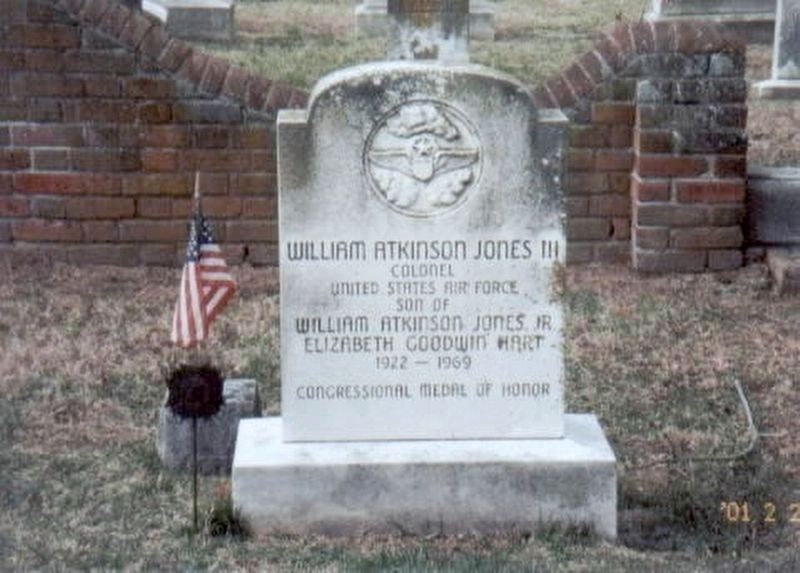
Photographed By Don Morfe, February 21, 2001
8. William Atkinson Jones III-grave marker
He is the grandson of Hon. William Atkinson Jones and is buried next to him in St John's Church Cemetery. He is a Vietnam War Congressional Medal of Honor Recipient. He was Killed in Action. His Medal of Honor information and citation is: *JONES, WILLIAM A., III
• Rank and Organization: Colonel, U.S. Air Force, 602d Special Operations Squadron, Nakon Phanom Royal Thai Air Force Base, Thailand
• Place and date: Near Dong Hoi, North Vietnam, 1 September 1968
Citation: For conspicuous gallantry and intrepidity in action at the risk of his life above and beyond the call of duty. Col. Jones distinguished himself as the pilot of an A-1H Skyraider aircraft near Dong Hoi, North Vietnam. On that day, as the on-scene commander in the attempted rescue of a downed U.S. pilot, Col. Jones' aircraft was repeatedly hit by heavy and accurate antiaircraft fire. On one of his low passes, Col. Jones felt an explosion beneath his aircraft and his cockpit rapidly filled with smoke. With complete disregard of the possibility that his aircraft might still be burning, he unhesitatingly continued his search for the downed pilot. On this pass, he sighted the survivor and a multiple-barrel gun position firing at him from near the top of a karst formation. He could not attack the gun position on that pass for fear he would endanger the downed pilot. Leaving himself exposed to the gun position, Col. Jones attacked the position with cannon and rocket fire on 2 successive passes. On his second pass, the aircraft was hit with multiple rounds of automatic weapons fire. One round impacted the Yankee Extraction System rocket mounted directly behind the headrest, igniting the rocket. His aircraft was observed to burst into flames in the center fuselage section, with flames engulfing the cockpit area. He pulled the extraction handle, jettisoning the canopy. The influx of fresh air made the fire burn with greater intensity for a few moments, but since the rocket motor had already burned, the extraction system did not pull Col. Jones from the aircraft. Despite searing pains from severe burns sustained on his arms, hands, neck, shoulders, and face, Col. Jones pulled his aircraft into a climb and attempted to transmit the location of the downed pilot and the enemy gun position to the other aircraft in the area. His calls were blocked by other aircraft transmissions repeatedly directing him to bail out and within seconds his transmitters were disabled and he could receive only on 1 channel. Completely disregarding his injuries, he elected to fly his crippled aircraft back to his base and pass on essential information for the rescue rather than bail out. Col. Jones successfully landed his heavily damaged aircraft and passed the information to a debriefing officer while on the operating table. As a result of his heroic actions and complete disregard for his personal safety, the downed pilot was rescued later in the day. Col. Jones' profound concern for his fellow man at the risk of his life, above and beyond the call of duty, are in keeping with the highest traditions of the U.S. Air Force and reflect great credit upon himself and the Armed Forces of his country.
The second instance evidencing the same faith was his able and indefatigable efforts to give to the Filipinos the fullest measure of self-government compatible with their political development and with the ultimate purpose of their complete independence. The merits or demerits of his views upon this subject I will not now discuss, save to observe that his service in behalf of these distant peoples was the crowning achievement of his public life as it was the supreme evidence of his political faith and philosophy. He firmly believed that all just governments should rest upon the consent of the governed. This conviction was the source and object of his constant activities.
Mr. Speaker, many here recall his presence on this floor battling for this ideal and for this legislation. We recall how he seemed to forget his physical limitations, and with a memory of all the facts and history involved in the question, with his soul aglow at the prospects of the larger liberties which the legislation would promote, by argument and tact and tenacity he guided through this House that great measure which will make his name blessed for evermore by the people of these far-away isles, as it is already embalmed in their grateful and fervent affections.
I accompanied him from the House to his committee room after the final passage of that measure. Tired and worn was he, but no word of personal exultation did he utter; only with winsome smile and subdued voice was a simple expression of gratitude that he had helped in his day and generation to extend the frontiers of human freedom. This was the great achievement of his long career, an achievement that will be memorialized in enduring form by the peoples of the Philippine Islands, and a culmination worthy of the best traditions of American statesmanship.
Mr. Speaker, I must now close my inadequate appreciation of this incorruptible public servant, this brave man, with resolute tenacity of purpose, with abounding confidence in the merits of any cause which he espoused, and fearless determination to give to it all of his strength and courage, to speak most briefly of his capacity for friendships. He had many friends and in them he saw little but what was good. He was slow to give his affections, but once given they were inflexible. It would be invidious to call the roll of his true and tried friends. But one I will ever remember, who from college to casket gave him an unbroken flow of affection, and who with sad face and moist eyes came in the early morning from another State to view the remains of his dead friend. And there are those of this Congress, amidst the associations of this Hall, who will recall the beautiful friendship so long existing between him and the brilliant De Armond, of Missouri.
I would not lift the veil which hides the outer world from the activities and felicities of his home life, save to say that he was a kindly neighbor, a delightful host, a dutiful and affectionate son, a true and faithful husband, and a generous and loving father. He truly met all of the near and tender relations of life.
His death has wrung grievously the hearts of many, and he will long be missed by his district, his State, and this House, in which he was for so many years a distinguished Member. The funeral committee of this House will ever vividly recall the glowing and gorgeous spring morning when troops of friends and neighbors gathered about the open grave in the cemetery of Saint John’s Church, in full view of his home, where amidst the singing of birds and the moaning of friends he was laid away in the soil he loved so well.
Mr. Speaker, he was ready for the summons. He was aware of the slender thread of life left him, for the pain and agony of his fatal disease told him only too plainly of the nearing end. But —Men must endure Their going hence as their coming thither; Ripeness is all.
He was indeed the “full grain in the ear,” ripe and hanging lightly to he plucked hy the Hand Divine. With courage and hope he quietly met the end, and at this hour I pay my homage to the memory of a true patriot, a great public servant, a noble and high-minded man, Virginia’s loyal son, America’s dauntless defender, and my dear friend.
— Submitted October 22, 2009.
Credits. This page was last revised on December 27, 2019. It was originally submitted on October 22, 2009, by J. J. Prats of Powell, Ohio. This page has been viewed 2,413 times since then and 57 times this year. Photos: 1, 2, 3, 4, 5, 6, 7. submitted on October 22, 2009, by J. J. Prats of Powell, Ohio. 8. submitted on August 30, 2017, by Don Morfe of Baltimore, Maryland.
